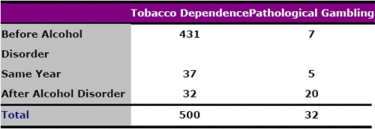"First things first, but not necessarily in that order."
-Doctor Who
Only a few studies have examined temporal sequencing of the signs and symptoms of addiction disorders (e.g., Shaffer & Eber, 2002; Simpson & Tucker, 2002). Perhaps the research focusing on temporal sequencing of addictive behaviors is scant because of the considerable difficulties associated with getting accurate and thorough data about the onset of illnesses. This lack of precedent does not translate to a lack of interest, however. Temporal sequencing studies can illuminate how disorders emerge and progress and perhaps how some disorders can contribute to the development of or protection from additional future disorders or future relapses. This week, the WAGER discusses a recent study of addiction patterns in Korea (Cho et al., 2002).
In 1984, Cho and colleagues (Cho et al., 2002) analyzed data from a nationwide epidemiological study of Korean community households, selected via a two-stage cluster sampling design. Family members 18 to 65 were interviewed using the validated Korean version of the Diagnostic Interview Schedule (DIS)
adapted from DSM-III. A total of 5,176 respondents participated (response rate 83.5%). To improve the representativeness of the sample, the author’s weighted the data by, sex, age, and location. For the study reported here, Cho investigated only those participants with a lifetime diagnosis of an alcohol use disorder (e.g. either alcohol abuse or alcohol dependence). Researchers then attempted to sequence alcohol use disorder and other comorbid disorders over a lifetime. Researchers diagnosed individuals as positive for lifetime disorder if the participant reported a minimum of two symptoms for the disorder. Cho et al. did not require the symptoms to co-occur in a specified time interval. Onset for each disorder was defined as the “age at which the first symptom(s) appeared and recency as the age of the most recent symptom” (Cho et al., 2002).
Of 500 males who suffered from an alcohol use and a tobacco dependence disorder during their lifetime, 431 developed tobacco dependence first, 37 developed tobacco dependence at the same time as the alcohol disorder, and 32 developed tobacco dependence subsequent to the alcohol disorder. Of 32 males who suffered from an alcohol use disorder and pathological gambling at some point during their lifetime, 7 developed pathological gambling before an alcohol disorder, 5 developed pathological gambling at the same time as an alcohol disorder, and 20 males developed pathological gambling subsequent to an alcohol disorder. No women were diagnosed as pathological gamblers.
Table 1. Temporal sequencing of tobacco dependence and pathological gambling as compared with alcohol disorder.
This data suggests that a tobacco dependence diagnosis is more likely to precede an alcohol use disorder and, conversely, that a pathological gambling disorder is more likely to follow an alcohol use disorder. The WAGER staff conducted a secondary analysis of the data reported by the authors and found a statistically significant difference (.2=114 df=2 p<.001) between the temporal sequencing of tobacco dependency and pathological gambling in relation to the onset of an alcohol disorder.
This study is informative, but some aspects of the methodology require closer scrutiny. Although researchers carefully re-analyzed their data for errors in generating diagnoses, and adjusted the data to reflect the 1980 census, this epidemiological data, taken from a 1984 sample, might have limited value for present day Korea. Pathological gambling rates could be quite different now in response to more advanced technology or changed public policy. In addition, we tested the differences between the temporal sequencing of tobacco dependence and pathological gambling for alcohol use disorder subjects for statistical significance. Our analysis supports their claim that “Tobacco dependence usually preceded the onset of alcohol use disorders in males…while pathological gambling tended to occur later” (Cho et al., 2002, p. 238). The authors did not perform statistical tests of this difference and other patterns where there were sufficient cases for analysis.
This research is one of only a few studies that has attempted to identify temporal patterns of different disorders that might significantly impact treatment. There exists a dearth of research seeking to identify the progression of psychological disorders; these studies have important implications for more accurately identifying co-morbid disorder patterns and particular disorder susceptibilities. Cho et al. found that “alcoholics are unlikely to seek medical consultation unless some other disorder is also present” (2002 pg. 240). This means that a person might suffer from an alcohol use disorder for some time before developing a pathological gambling disorder — and then seek help. Therefore, proactive education about the symptoms of alcohol use disorders and readily available treatment options might provide early detection of alcohol disorders and protect drinkers from developing other disorders. Alternatively, early detection of gambling-related problems might identify the need for integrating alcohol treatment into the clinical care program.
Comments on this article can be addressed to Michael V. Stanton.
References
Cho, M. J., Hahm, B.-J., Suh, T., Suh, G.-H., Cho, S.J., & Lee, C. K. (2002). Comorbid mental disorders among the patients with alcohol abuse and dependence in Korea. J Korean Med Sci, 17, 236-241.
Shaffer, H. J., & Eber, G. B. (2002). Temporal progression of cocaine dependence symptoms in the national comorbidity survey. Addiction, 97, 543-554.
Simpson, C. A., & Tucker, J. A. (2002). Temporal sequencing of alcohol-related problems, problem recognition, and help-seeking episodes. Addictive Behaviors, 27(5), 659-674.





